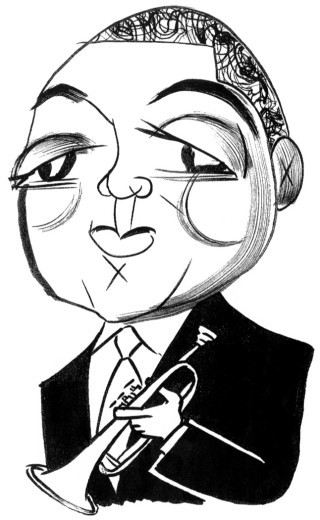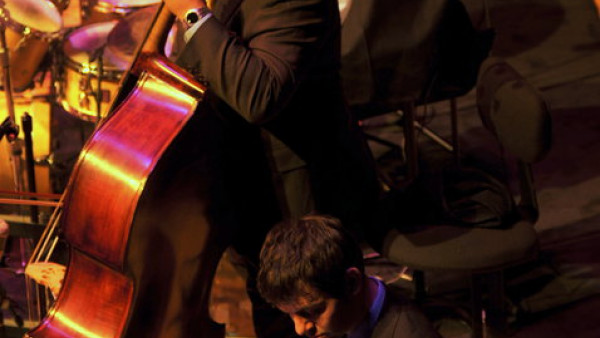Two beats

Around three-fifteen on a recent afternoon, the trombone player and music producer Delfeayo Marsalis sat in the control room of a studio in the West Fifties and said to his brother Wynton and eleven other musicians, “We’re rolling, this is Take 68.” The musicians were recording “Tournament Galop,” a Romantic piano piece that was written by Louis Moreau Gottschalk, who was born in New Orleans in 1829. Take 67 had been Brahms’s Hungarian Dance No. 6, also written for the piano but arranged in this case for piano and brass. Both pieces will accompany a new silent film, “Louis,” a fictionalized account of the childhood of Louis Armstrong. When “Louis” is shown, in five cities over seven days at the end of August, Marsalis and the others will perform the score live. They were recording the soundtrack for a CD.
The arrangement for “Tournament Galop” was done by Andy Farber, who conducted it, and includes sections for classical piano, which were played at the session by Cecile Licad, who is highly admired around the world. She is small and dark-haired, from the Philippines, and when she wasn’t playing she held her hands in her lap, if her rests were long, or above the keys, if they were brief. Farber counted off, “One, two, three, bah, bah,” and there were two swift reports from the brass, like a fanfare, then the theme was stated, passed rapidly back and forth, and Wynton took a sly and slithering solo, rolling his shoulders while he played. Everything went smoothly until a tricky passage around the middle. In it, a rising figure is played by the piano and then repeated by the horns. Some of the horns play the piano’s left-hand part, and some play the right.
Not only was the passage demanding; Licad also played it faster than was strictly called for. “She’s used to playing it by herself,” a man in the control room named Scott Steiner said, sounding concerned. Following other musicians, he said, was “counterintuitive for her.”
The effect of Licad’s speeding up was that the horn players had to adopt her pace instantly and then chase her. Nobody wanted to say that she was making a mistake or offer any suggestion that might inhibit her playing—aside from her eminence, she was a kind of guest, since the other musicians were either members of Wynton Marsalis’s band or people he had played with before. “For her, it’s like being invited to a party where everyone knows each other and she doesn’t know anyone,” Wynton said later.
Hoping to find an oblique solution, Farber asked, “What about a fermata”—a pause to consolidate the tempo—“on the first part of bar 292?”
“That wasn’t our problem,” Wynton said, matter-of-factly. “It was 296.” He played a few quick phrases, then stretched his lips as if they were appendages, like a runner shaking off tension after a sprint.
A series of unusable takes followed, then one of the horn players asked Farber if he could sing their part. His voice rising like an escalator, he scat-sang, “Du-bah, da-bah, du-bah, da-bah, du-bah, da-bah, dah.” Then Wynton, elaborating on a part within the phrase, added, “Ban, ban, do, do, dah, dang.”
An uneasy pause followed. “It’s like that section in ‘The Nutcracker’ that we never used to get right, either,” Farber said, finally.
Wynton, planting the bell of his trumpet in his lap, stared at the score on the music stand in front of him. Later, he said, “The problem was a time issue. Let me see if I can describe it so it makes sense.” (He couldn’t.) “It’s two-beat music, and we’re three generations away from her. We’re leaping over a lot of resistance to go where she’s playing.”
Eventually, a conference was held in the control room. Then Steiner walked into the studio and moved one of the microphones closer to the drummer’s high-hat cymbal, in the hope that it would enable Licad to hear the tempo more clearly. The gesture was made unobtrusively, as if, in other circumstances, to address a subtle but essential matter of protocol. Then Farber snapped his fingers and said, “All right, here we go—one, two, uh, uh, uh,” and this time they made it all the way to the end, with Licad playing forcefully but only slightly faster through the passage, and the horn players falling in briskly behind her. A single short task was left: for the musicians to repeat the two beats of sound at the finish, then to sit without moving, so that on the CD several seconds of silence would follow the end of the song.
– by Alec Wilkinson
Source: The New Yorker

